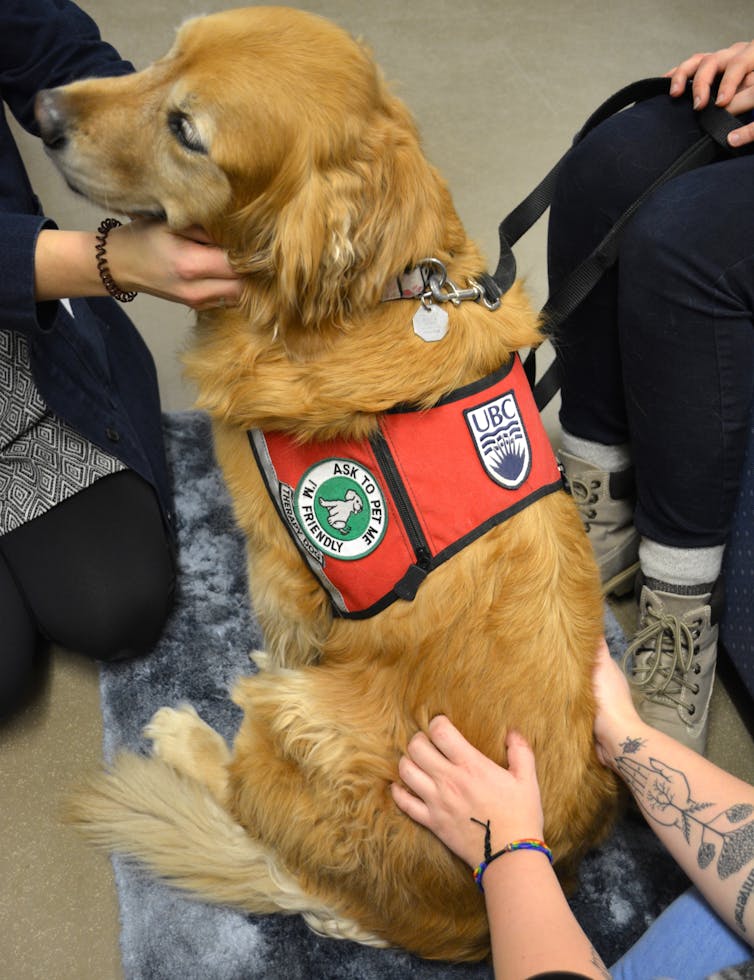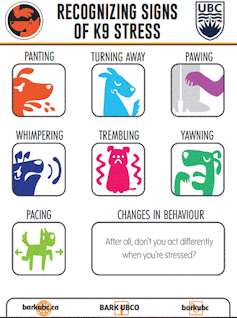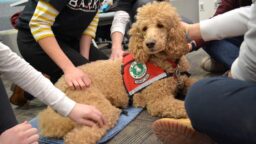The interaction always played out the same way. I’d leave my office and make my way across campus in search of coffee, my dog Frances by my side, and I would be besieged by students who, for the most part, would ignore me and lose themselves in Frances. They would eventually look up with tear-filled eyes and say: “As much as I miss my parents, I miss my dog more.”
Now, seven years later, I run a large dog therapy program at the University of British Columbia. With 60 therapy dog teams, we offer programs to reduce stress and boost students’ wellbeing.
The B.A.R.K. program — Building Academic Retention through K9s — creates opportunities for students and community members to spend time with therapy dogs.
We offer a weekly drop-in program on Friday afternoons. For students who can’t attend that session, we have therapy dog teams stationed throughout the campus strategically near the coffee shop and in the library at other times.
The 60 therapy dogs we have in B.A.R.K. are mostly male, are all around four years old. Thirty-six per cent of them are mixed breeds, thus challenging the prevailing stereotype that only golden retrievers make good therapy dogs.
We work closely with a local rescue group, Paws it Forward which rescues dogs from high-kill shelters in the United States and elsewhere. Once these dogs are adopted, many of them find their way into our program.
We also build leadership skills in children from the Okanagan Boys & Girls Club, and provide stress reduction opportunities for police constables at the Kelowna Royal Canadian Mounted Police Detachment. It’s rewarding work for sure.
Why dogs on campus?
Life as a university student is usually thought of as an exciting and engaging time of one’s life. But for many it can feel not dissimilar to moving into a seniors’ home, in the sense of living away from home, leaving family and pets behind and adjusting to a potentially impersonal institution.

In fact, this transition sees first-year university students, especially in the first semester, experience heightened levels of homesickness.
Providing students with access to therapy dogs helps fill a void caused by this upheaval and helps to ease the transition from high school to university.
These first-year university students are adjusting to increased academic expectations and figuring out how to establish new social networks. Once they are suddenly free from the watchful eye of parents, they can thrive in their new environment or feel as if they are drowning in it.
Universities are increasingly seeking ways to support those students who need assistance with the transition from high school. No longer concerned only about students’ academic success, modern universities also strive to support their social and emotional wellbeing.
Students who fail to make the transition from high school to university are at risk for compromised mental health and potentially dropping out, which comes at a cost to not just the student, but the university too.
This is where therapy dogs come in on campuses. A 2015 study identified more than 925 canine therapy programs across U.S. college campuses and programs, but to date, no known comprehensive research is available about the number of canine therapy programs at Canadian post-secondary institutions.
After seven years, here’s what I’ve learned about supporting university students through canine therapy.
1. Dog welfare is key

Exposing a group of therapy dogs to stressed university students is no small undertaking and efforts must be made to safeguard the welfare of therapy dogs working in sessions.
You can’t have human stress decrease at the expense of therapy dog wellbeing, so dogs in our program are carefully monitored for signs of distress. As part of their orientation, handlers learn to recognize the indicators of canine stress.
2. Being with dogs reduces student stress
Over the course of three semesters, we documented how 1,960 students confidentially assessed their stress levels upon arriving at a dog program and when departing. We found students’ stress reduced significantly from an average arrival rating of 4.47 on a five-point-scale to 1.73 on the same scale after being with dogs.
3. The half-hour sweetspot
Some programs will set limits on how long students can visit with dogs.
However, we identified that when given the option to stay until they felt their stress was sufficiently reduced, university students stay, on average, 35 minutes.
4. Dog therapy can be low-cost
Although a therapy dog program can provide a number of logistical challenges, structured properly it can be relatively low-cost.
The costs associated with running a program are borne largely upfront in the screening, training and assessment of therapy dogs and their handlers. As these programs run predominantly on the efforts of community volunteers, once dog-handler teams are identified, the costs are not prohibitive.
5. Programs must be flexible
There can’t be too many barriers impeding students’ access to dogs. Students, especially stressed students, don’t like to wait. Providing access to enough dogs to meet the demand can be a challenge.
6. It’s not just for first-year students
Although first-year students account for the bulk of our student visitors, we see students from across the undergraduate years. Generally, more female than male students seek to interact with therapy dogs.
We also see faculty, staff and community members make use of our programs. Although post-secondary faculty in particular experience heightened occupational stress, we have not yet assessed the effects of therapy dogs on faculty or staff stress.

At our drop-in space, you’ll find snacks, friendly dog handlers trained in facilitating interactions, and therapy dogs eager to comfort students who admit to missing their dog back home a little more than their parents.
Author: John-Tyler Binfet, Associate Professor, Faculty of Education, University of British Columbia
This article is republished from The Conversation under a Creative Commons license. Read the original article.



